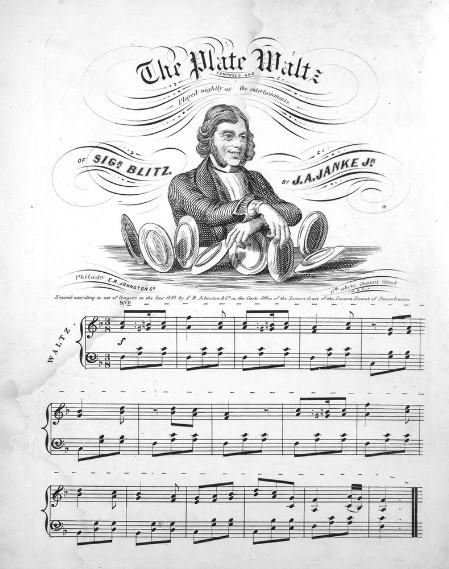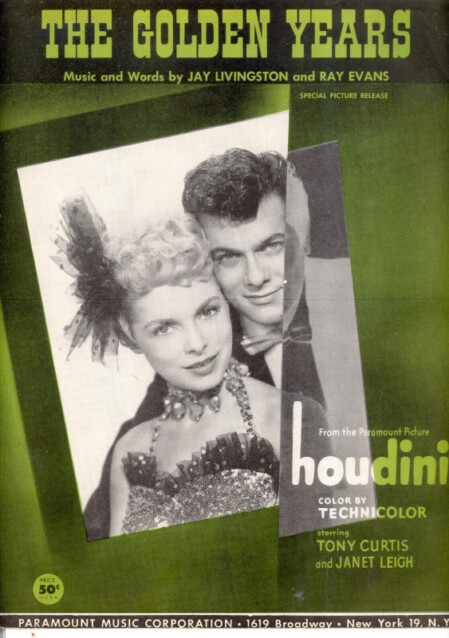Musical Magic - Magicians' Sheet Music
Numerous magicians of old had music composed for their shows, or tunes dedicated to their performances. The music for these melodies often had evocative front covers which have been published, but it is rare to find an audio transcription of the music itself. These tunes have been transcribed by me using SmartScore notation software, scanned directly from the sheet music and edited to the best of my ability. Some of the published notation is poorly written, with errors of note values, missing or confused repeat marks etc; so some choices of notation are mine. Dynamics have been lightly used, since these are mostly vigorous concert pieces.
In general, these tunes will be confined to those directly connected to a magician or related performer, a clear magical theme, or where the composer was himself a magician. While related genres such as 'cards' or 'gambling' may have interesting cover images, they are not within the scope of this page; neither are general 'popular' songs which have been used as accompaniment to a magic act.
Page 1 - Magical |
Quadrille Mignonette - 1845
Composer Aristide Le Carpentier produced five short pieces of music which were bound in the gilt maroon cover of tiny souvenir albums (125 x 105mm).
They represented feats from the repertoire of his friend, French magician Jean Eugene Robert-Houdin, who produced these miniatures from his magical "Cone of Abundance" for distribution to his audiences c.1845
They represented feats from the repertoire of his friend, French magician Jean Eugene Robert-Houdin, who produced these miniatures from his magical "Cone of Abundance" for distribution to his audiences c.1845
Music source: Auction catalogue of Potter and Potter Auctions, December 2023.
The Plate Waltz - 1849
Signor Antonio Blitz performed his Plate Spinning act in Philadelphia. J.A.Janke jr's waltz was played by Janke during the performance.
Music Source: The Lester S. Levy Sheet Music Collection
Music Source: The Lester S. Levy Sheet Music Collection



Herrmann Polka - by Johann Strauss II - 1851
Possibly the most prestigious association between a musician and a magician; the famous Johann Strauss II dedicated this Polka (his Opus No.91) to Carl (Compars) Herrmann, famous magician and older brother of Alexander Herrmann, when the two met in Vienna in 1851. The Polka was first performed on June 14, 1851 at a charity ball in the the dance hall Zum Sperl.
The music covers and interiors sometimes incorrectly spell the name as "Hermann"; it should be "Herrmann".
The text cover is presumed to have been published close to the original composition, and while the illustrated cover of the Polka is not dated, it is likely to be around the same time as the variant "Polka and Quadrille" published with a date of 1862 shown at the bottom of the oval border.
The text cover is presumed to have been published close to the original composition, and while the illustrated cover of the Polka is not dated, it is likely to be around the same time as the variant "Polka and Quadrille" published with a date of 1862 shown at the bottom of the oval border.
The Quadrille, notation for which has not yet been located was almost certainly composed by Boston musician, Charles O. Pape.
Strauss' composition can also be heard in orchestral form at https://www.youtube.com/watch?v=MQ1V1Yfojbs
The Wizard's Polka - 1851
by James Bellak (see also the "Keemo Kimo Schottisch")
Published by Lee & Walker 162 Chestnut Street Philadelphia
Dedicated to J. Hall Wilton, theatrical agent was connected with singer Jenny Lind,
actors G.V.Brooke and Barry Sullivan, and magicians Robert Heller and the Wizard Joseph Jacobs.
He died in Sydney in 1862 and is buried in Camperdown cemetery.

The Inexhaustable Waltz - 1851
Composed and arranged for the piano forte expressly for Professor Anderson's
Grand Drawing Room entertainments, by Mons. Kneringer
1st Prize Merit Pianist from the Conservatoire Royal de Paris
(Mons. Kneringer appears to be Victor Kneringer, composer, and Professor of the Baptiste Female College, Danville Va.)
Publisher: Samuel C. Jollie, 300 Broadway New York
Registered by Prof. Anderson at New York, 1851
Cover illustration: Sarony & Major
Interior credit reads: Inexhaustable, Grande Waltze pour le PianoForte
Composee et dediee a Mad. V. R. Moifsang
Par Gabriel H. Le Gras
- it is unclear how this relates to Kneringer's credit as composer.
- it is unclear how this relates to Kneringer's credit as composer.
With thanks to Raymond Ricard for source material.

The Magical Olio - 1854
A series of six 'beginners' works composed by Francis H. Brown. Published in Philadelphia by J.E. Gould.
The magic link is a little tenuous, but the image of the magician and the magical titles of the pieces make this a valid inclusion. See also "Magic Sounds for Piano, 1859" which uses the same cover image.
Music Source: The Lester S. Levy Sheet Music Collection
MP3 audio transcriptions:
Keemo Kimo Schottisch - 1854
by James Bellak
Dedicated to Wyman the Wizard
(John Wyman Jr. (1816-1881) - U.S. magician and ventriloquist)
Music source: Lester S. Levy Sheet Music Collection
Wyman's Polka - 1854
by John A. Janke, Jr. (see also Blitz's "Plate Waltz")
Published by Winner & Shuster, 110 North 8th St Philadelphia
Dedicated to John Wyman Jr. (1816-1881) - U.S. magician and ventriloquist, "Wyman the Wizard"
Music source: Lester S. Levy Sheet Music Collection
Magic Sounds for Piano - Western Belle Scottisch - 1859
Since there is effectively no connection to magic, other than the cover image, the 'Western Belle Scottisch', composed and published by Chas. S. Brainard is the only work transcribed here.
The same image had been used on the cover of "The Magic Olio" 1854
Music Source: The Lester S. Levy Sheet Music Collection
The Mystic Polka - 1862
Composed 1862 by J.A. Fowler for the "Wizard of the North", John Henry Anderson to be used in his Grand Soiree Mysterieuses.
Music Source: The Lester S. Levy Sheet Music Collection
Polka D'Illusion Magique - 1866
Composed by Juliet Levy for Joseph Michael Hartz (1836-1903)
Music Source: Lester S. Levy Sheet Music Collection
Aerial Bell Polka - 1870
by Louis Haselmayer
Published by A. E. Blackmar, 164 Canal St, New Orleans
Published by A. E. Blackmar, 164 Canal St, New Orleans
Music Source: source - https://www.loc.gov/item/2023789104/
La Malle des Indes (The Trunk of India) - 1875
By Georges Lamothe, Dedicated to "my friends [Emile] Robert-Houdin and
Brunnet".
Around 1873, Jean Robert-Houdin’s son, Emile, took
ownership of the Theatre Robert-Houdin, and arranged for Pierre Edouard Brunnet
to present the shows. The programme included the locked-trunk escape artist act
"Malle des Indes”, which may have been originated by Charles De Vere. The performer’s assistant escaped from a locked trunk and
then returned inside the trunk.
There are several versions of the sheet music including
2-handed and 4-handed versions, and a variant titled “The Indian Mail” arranged
for four hands, by D.F.Stillmann.










Riding on the Top of an Omnibus - 1886
by George Walter Hunter (1850 - 1936)
This is a single representative song from many by G.W.Hunter, whose main career was as a music hall singer of comic songs in both Britain and America.
He was also an extensively published inventor of magic tricks, most famously for his 'Hunter Knot' and 'Hunter [f] Shuffle'.

The United States Wheel March - 1895
The Chicago Stamping Company, manufacturers of metal goods, produced "United States Wheel" wheels and bicycles from 1895, the publication date of this March. The company closed in 1898.
There were at least three variant publications of the March, one of which was "presented with the compliments" of Minnesota magician Frederick Bancroft (1866-1897).
Composer: Charles Smith Tarbox (Op. 333)
Music Source: https://levysheetmusic.mse.jhu.edu/collection/061/059

Pheon Waltz Song - 1896 & 1897
Written and published by Jessie L. Davis, Milwaukee Wis.
Dedicated to Mme. Adelaide Herrmann (1853-1932), "as performed for Mme. Herrmann's dance."
The longer 1896 edition includes dance breaks between verses. Song version distributed as a supplement to The Examiner, Nov.14 1897

The Awakening of Venus - 1898
By William Christopher O'Hare
Dedicated to Madame Adelaide Herrmann
Music source:
Magician Waltz - 1902
Written and published (Kansas) by W. H. Adams
Dedicated to Don Turley (cover photo), Kansas magician and student of Edward Maro.
Music Source: https://dl.mospace.umsystem.edu/umkc/islandora/object/umkc%3A14455#page/1/mode/2up
Australia's Got a Navy of Her Own - 1911
Words by Alf .G. Lumsden (the illusionist "Czerny"), music by W. E. Naunton
from the 1911 pantomime "Babes in the Wood" by Lumsden.
Music Source: https://nla.gov.au:443/tarkine/nla.obj-166372778
Thurston March & Two Step - 1913
Illusionist Howard Thurston (1869 - 1936)
Written and published (Cleveland) by Anthony J. Stastny Music Co.




Hindu Man- 1921
by Jeff Branen and Frederick G. Johnson
Cover art by magician Harlan Tarbell
Published by T.S.Denison & Company, Chicago
Tarbell was a prolific artist, and provided artwork for many sheet music covers, particularly
for T.S.Denison in stereotyped "minstrel" caricatures which today are regarded as racist.
Jonah - 1922
by Harlan Tarbell and Frederick G. Johnson
Published by Eliza Doyle Smith 59 E.Van Buren St Chicago
Tarbell was a prolific artist in many fields, and the author of the famous Tarbell Course in Magic.
Music Source: yorkspace.library.yorku.ca
Dante's "Sim Sala Bim" Fox Trot - 1931
Words and Music by Alvin Jansen (son of Harry 'Dante' Jansen)
Arranged by Karl Pecke for full band. (Transcribed from Piano chart)
Published by Universum Ed. Prague.
(incorporates themes of Rhapsody in Blue, New World Symphony Mv.1, and Away Down South in Dixie)



Sawing a Woman in Half - 1935
Music - Kay Swift
Lyrics - Al Silverman
Pub. Edward B. Marks Corporation

The Golden Years - 1953
From the Paramount movie "Houdini" 1953
starring Tony Curtis and Janet Leigh.
Words and Music by Jay Livingston and Ray Evans
Pub. Paramount Music Corporation NY
